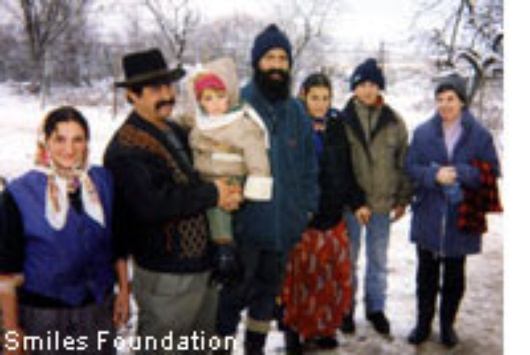The largest trans-European minority
Published on
Translation by:
 sophie de'ath lancaster
sophie de'ath lancaster
In Europe, the Roma are often brought up when discussing the problem of minorities. In a Union without borders, this unrecognised people navigate between the east and west, between integration and discrimination, and are yet to find their place
 ‘Travellers’ or ‘Gypsies’. These simplistic definitions hide the true identity of the 10 million Roma who live in Europe. Originally from North India, they started to move into Eastern Europe in the twelfth century and today they make up the largest European minority. The ever expanding European Union cannot ignore them any longer: two thirds of them live in Central and Eastern Europe. Romania and Bulgaria in particular have large Roma populations, and both these countries are candidates for EU membership in 2007.
‘Travellers’ or ‘Gypsies’. These simplistic definitions hide the true identity of the 10 million Roma who live in Europe. Originally from North India, they started to move into Eastern Europe in the twelfth century and today they make up the largest European minority. The ever expanding European Union cannot ignore them any longer: two thirds of them live in Central and Eastern Europe. Romania and Bulgaria in particular have large Roma populations, and both these countries are candidates for EU membership in 2007.
No country
This mixture of people, which has been labelled with so many derogatory terms, is far from disappearing. The true Roma identity has a tendency to become blurred due to the variety of terms used to describe them. ‘Roma’ is commonly used to describe continental Gypsies, but then the term ‘Gypsy’ is often confused with ‘traveller’. This lack of precision makes any translation difficult as it blurs the slightest differences between the groups and encourages more general perceptions. To complicate things further, not all travelling people are Roma and, conversely, many Roma have adopted a more sedentary way of life. While travellers are usually either people pushed into the nomadic lifestyle due to economic reasons or out of the desire to find something more fulfilling, the Roma are an ethnic group. Thus the term ‘Roma’ links this European minority to its Indian origins of eight centuries ago.
The media regularly report the latest problems caused by Roma, who are stigmatised and often seen as foreigners in the country in which they live. In mid-January 2005, a scandal broke out in Spain where many Gypsies live and where tensions persist. After a demonstration following a murder, the Gypsy quarter was sacked. Many demonstrators set fire to barns, turning over cars and even throwing stones through the windows as a means of vengeance. Hate towards the Gypsy community, which has been suppressed for a long time, has reappeared after years of peaceful cohabitation.
In England, ‘travellers’ are more of a political concern than Roma in the strictest sense. However, in the campaign surrounding the upcoming general election on May 5, candidates have targeted Gypsies as a major concern. The Tory leader Michael Howard has blamed illegal encampments on the Human Rights Charter for making it difficult to punish those who flout the law. The tabloids have jumped on the bandwagon, claiming the current Government encourages these populations, with The Sun going as far as declaring “War on Gypsy free-for-all”.
Meanwhile in Germany the Roma population has recently had problems in Ravensburg. The National Council of the Sinti and Roma in Germany confirmed that the government is partly responsible for racist acts against their compatriots. For example, a town counsellor had stopped an enquiry into the citizen responsible for placing a banner on a float during a carnival procession last march. “Zack, zack, Zigeunerpack.” (Look sharp! Dirty Gyppos!), should not have been allowed by the council.
The start of April, in an interview for Le Monde, Dana Diminescu, sociologist and author of a work on the migratory circles of Romanians, mentioned the difference between the Roma and Romanian immigrants, often confused in the eyes of the public. According to her, the Roma are more noticeable as they travel between Paris and Lyon. They continue their tradition of coming and going, and have strong links to their clan or family, whereas “the Romanians live individually which means that they blend more easily into the European countryside.”
In central and eastern Europe the Roma group is well known. Here they are more numerous, having arrived two centuries ago, before their migration to the west: half a million Roma live in Hungary, nearly as many in Slovakia, and around 250,000 in the Czech Republic. Romania and Bulgaria, future members of the Union in 2007, have around two to three million Roma.
United in their European identity
But existence does not mean recognition. Due to the discrimination which they encounter in various regions, the Roma are a key group for integration policies. Indeed, legislation says that they are a minority which must be taken into consideration by the new and future EU members if they want to have the chance to join. Moreover, the Roma represent the best example of ‘Europeanism’ aimed for by European integration. Whether or not they are nomadic, they pride their freedom and do not see borders as a limit to their travels. They define themselves as a “nation without territory” and “a European people” and claim to be in Europe wherever they may be. The resistance which they face only goes to show the obstacles which an expanding EU must deal with in order to realise its process of integration.
One day maybe the press will mention the Roma under the European section and not with the national news, where the Roma are portrayed as an unwanted foreign element. When the media achieves this, only then can European integration be discussed.
Translated from La plus grande minorité « transeuropéenne »


